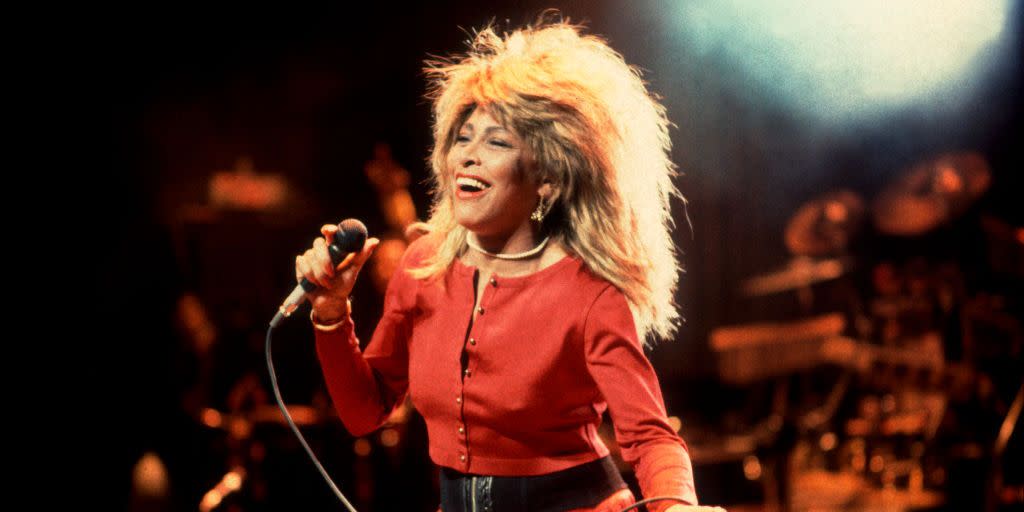Tina Turner Is Pure, Eternal Energy

- Oops!Something went wrong.Please try again later.
There are emotions one expects to feel upon the death of an octogenarian, and shock is not on that list. Yet here we are: Tina Turner—singular entertainer, patron saint of resilience and tenacity, the embodiment of the word oomph— has died at the age of 83, and it feels like there’s been some kind of mistake. Are they sure?
You know her story, if you have seen What’s Love Got To Do With It. You know the shimmy and the strut that Mick Jagger stole. You know about the abuse, and the industry that wrote her off, and the big comeback from all of it, and if you don’t, she will tell you about it in her autobiography, the commandingly-titled (and appropriately so) I, Tina. You know her songs, if you are alive.
What you may not know, unless you were there to see it, is how Tina Turner landed in our culture. Particularly how she re-landed, re-establishing herself once and for all for the second time, right in the middle of the greatest year in pop music history.
Tina Turner was a name we were familiar with in 1984, because she’d been famous for around a quarter-century already. Check her out on Shindig! in 1960:
But by the late 1970s, after she left Ike and started on a solo career that didn’t quite take off, we knew her mostly from variety shows. A major talent and a style icon, but directionless. So when she’d turn up doing a Beatles medley on The Cher Show with Kate Smith, we thought: Yeah, that feels right.
And that could have been that. Tina released a couple of solo albums, and neither one got much attention. She was relegated to corporate gigs, and this won’t make sense from today’s perspective, but at the time corporate gigs were unseemly. Vegas residencies, too. You were allowed to leave money on the table back then, and if you didn’t, it suggested that you couldn’t.
The opportunities might have dipped a bit, but the voice and the commitment and the oomph never did. In 1983, David Bowie was in New York City, celebrating his own mid-career comeback album Let’s Dance. Instead of throwing a party, Bowie said he wanted to go to The Roxy to see his favorite singer: Tina Turner. The word spread, because where David Bowie went was where any sensible person would try to be. He might have got them to The Roxy, but she kept them there. The executives pulled out their pens, and soon enough she had a new deal with Capitol Records. Private Dancer landed right around the same time as the video for “What’s Love Got To Do With It.”
This was mid-1984, MTV was the dominant force in the culture, and this will make sense from today’s perspective: you were not allowed to be in your forties on MTV. The video age sent labels on the hunt for younger, fresher. But Tina gave us experience, grit, depth. She knew more than the kids, and she sounded better besides. With Private Dancer, particularly with this video, Tina Turner proved that the question of age didn’t have to be dignified with an answer. It could just be shimmied past.
The success of Private Dancer didn’t feel like a comeback, it felt like a correction. Like there had been a mix-up at the front desk and she’d finally been moved up to the Presidential Suite where she was supposed to have been the whole time. She did not become iconic in the mid-'80s. The world just became aware.
I, Tina was adapted into the movie What’s Love Got To Do With It in 1993, and Tina showed up for its premiere at the Cannes Film Festival. With the film’s director, and its star Angela Bassett sitting right there, here’s what she had to say about it:
Thanks for the biopic, not seein’ it. Tina was constantly moving forward. That’s the key to resilience and tenacity, and it’s why she stayed on top once she got back up there, and it’s probably also why she got the hell out of this country and became a Swiss citizen. She got what was hers, she enjoyed getting it, and then she just enjoyed. What a life.
Ten years ago, here’s what she had to say about mortality:
Damn right.
What’s surprising, when you think about it further, is that Tina Turner had an age at all. She always felt more like a force than a person—indestructible, eternal. Tina Turner was pure energy, and energy cannot be created or destroyed. No matter what the news says.
You Might Also Like

